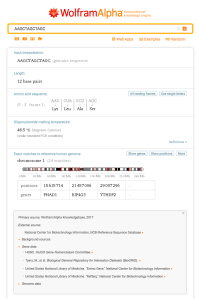Databases
There are many free, open-access databases which can be used for tasks ranging from simple data-finding to more authentic retrieval and analysis. As biosciences become increasingly informatic in nature, knowing how to access, use and interpret is a valuable skill.
Databases in IB Bio
Through the IBBio course, students should learn how to access and use databases for reliable information. It is also possible to use databases as the source for IA investigations, though this would need to be carefully managed.
Sample IA using database access: Is there a relationship between countries Human Development Index (HDI) and the incidence of tuberculosis? (IBBio Teacher Support Material)
A challenge with using informatics/databases in IA work will be generating quality questions that can be explored effectively. However, there is huge potential for student exploration of real science in action and it might be worth exploring this with students, using the sample above, its feedback and plenty of time and provocation for ideation.
Databases might help in cases where there are insufficient data for analysis beyond the superficial (TSM). These are known as secondary sources of data – rather than primary experimental data (Bio Guide), and may allow for more efficient progress in IA work.
Example Databases
- Global Invasive Species Database
- CITES endangered species database
- ReefBase coral reef health survey data
- Wallace Resource Library
- USDA nutrients database
- WHO Global Health Observatory
- NOAA Climate and weather databases
- Menstrual cycle hormones database (and spreadsheet)
- Entrez gene sequence database (here’s our activity)
Data Nuggets
This is really cool, thanks @ibscience for sharing. A website devoted to data use in schools, connecting authentic datasets to the stories behind them. Here are some example DataNuggets and here are some datasets and links.
……….o0O0o……..
Wolfram|Alpha

Try Wolfram|Alpha
Wolfram|Alpha is an amazing computational search engine. Although not a database by itself, all results returned are sourced and students can access original data. For example, it can be used to re-create the queries in the sample IA above [HDI – Tuberculosis].
It’s great for gene data, climate, socioeconomics, nutrition, species and so much more.
I have a subscription to Wolfram|Alpha Pro Educator, from which you can download datasets and set practice questions in mathematics. It will also accept data for analysis, including t-tests.
……….o0O0o……….
Databases in Action: Gene Sequencing & Cladistics




Leave a comment
Comments 0